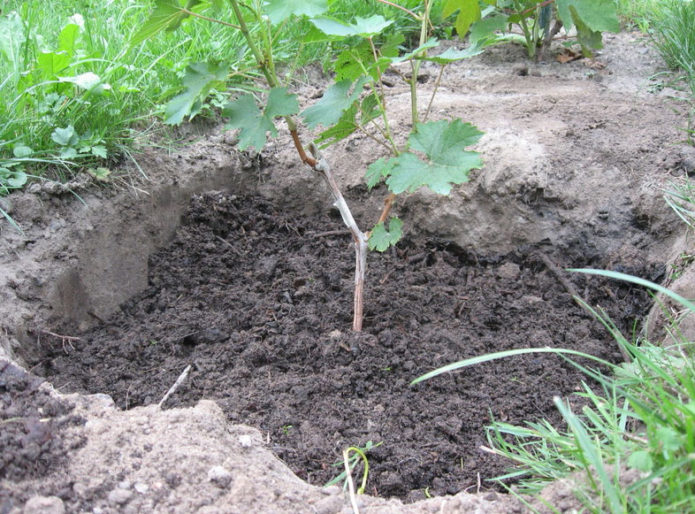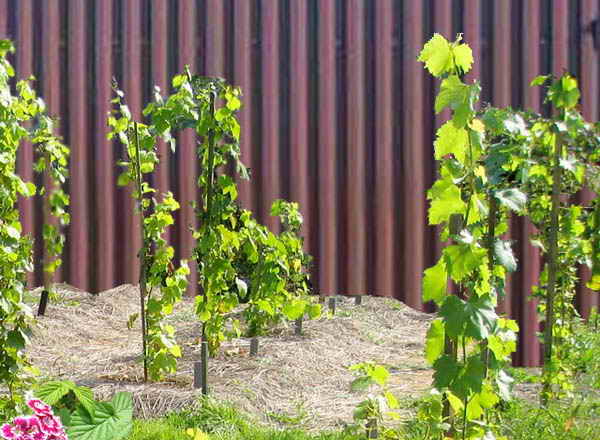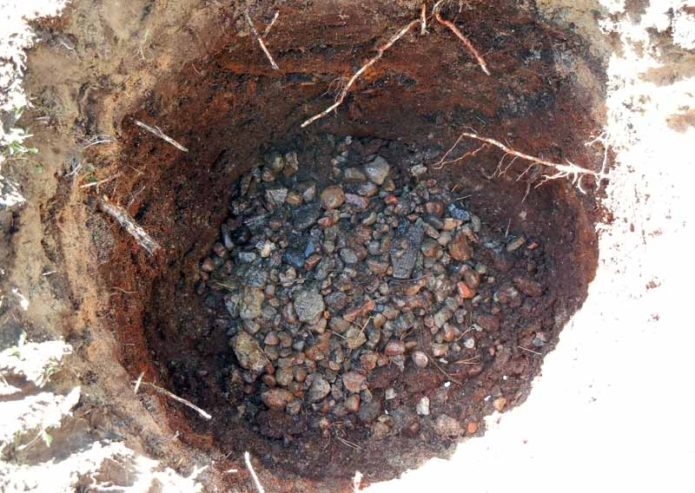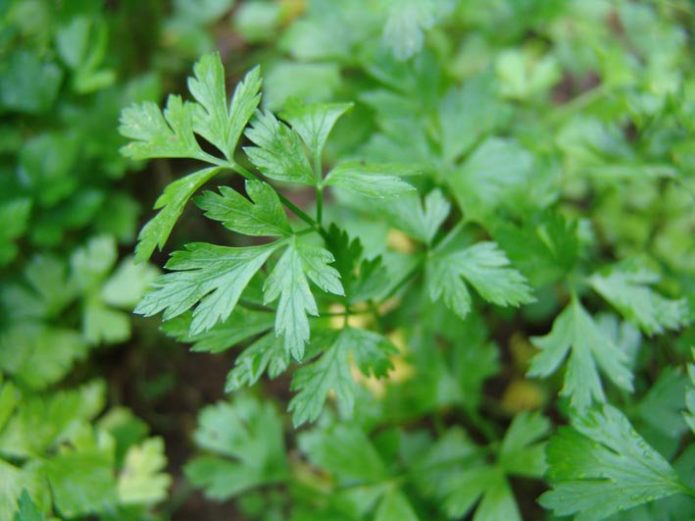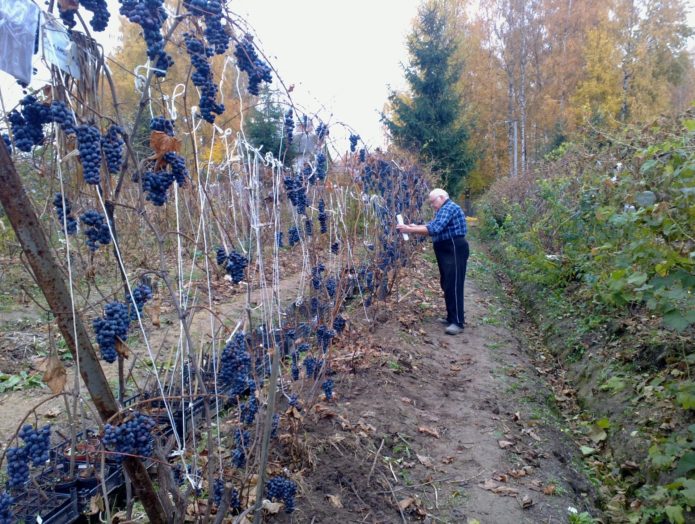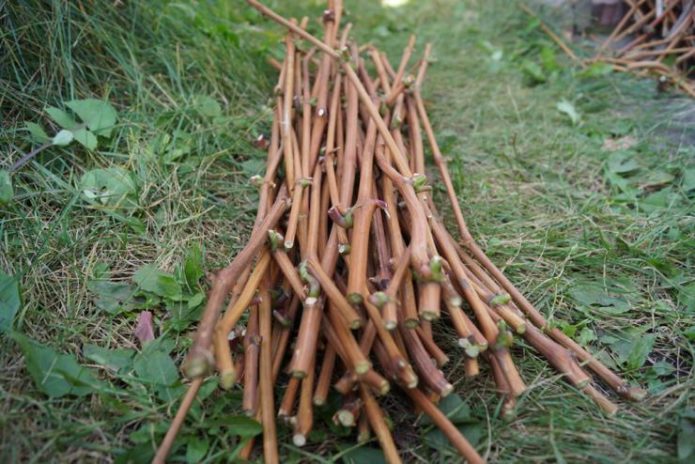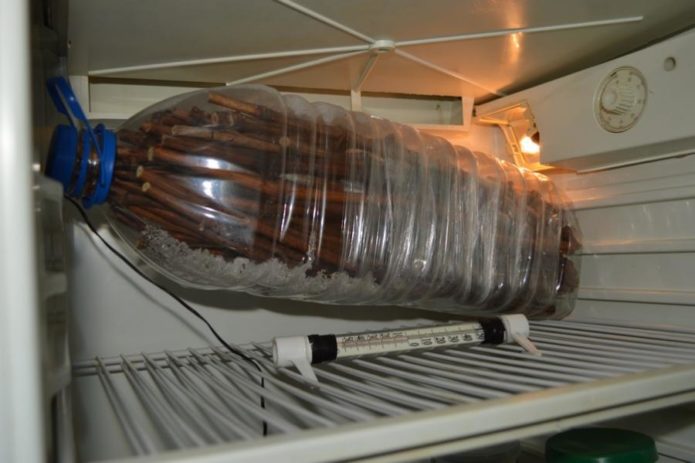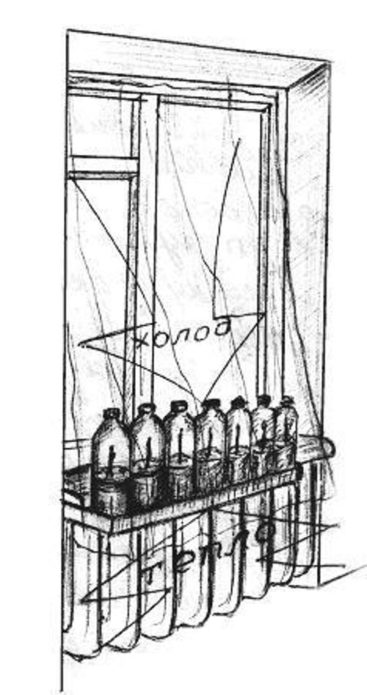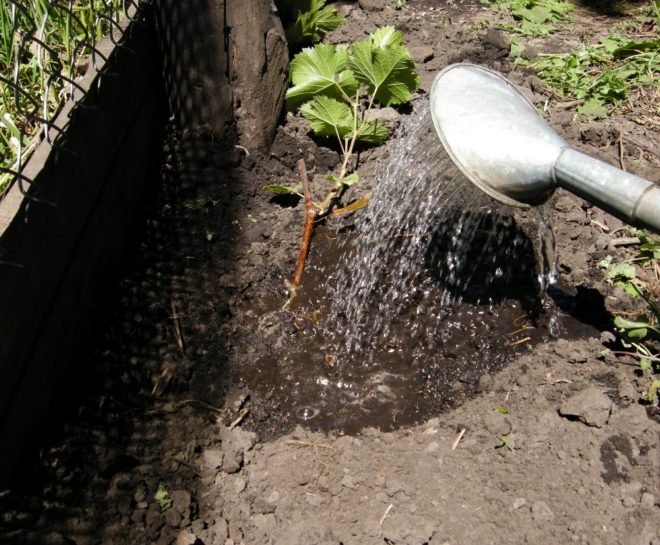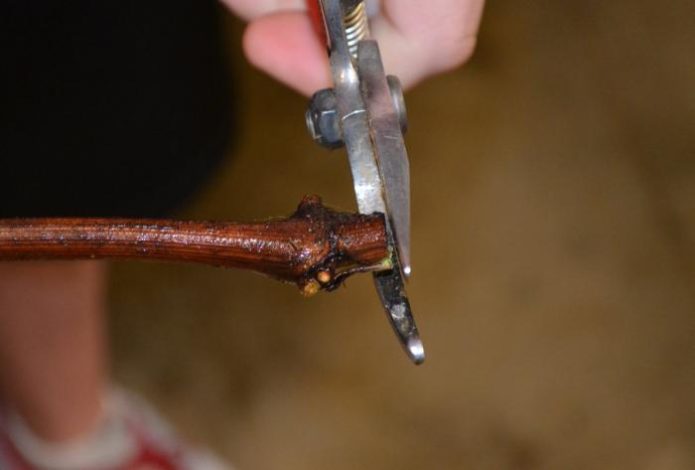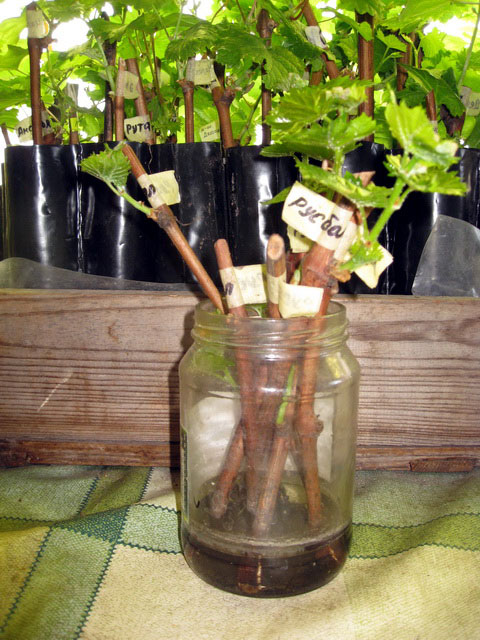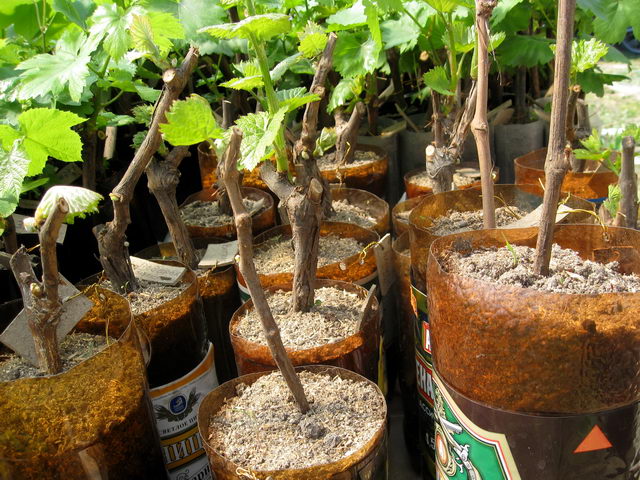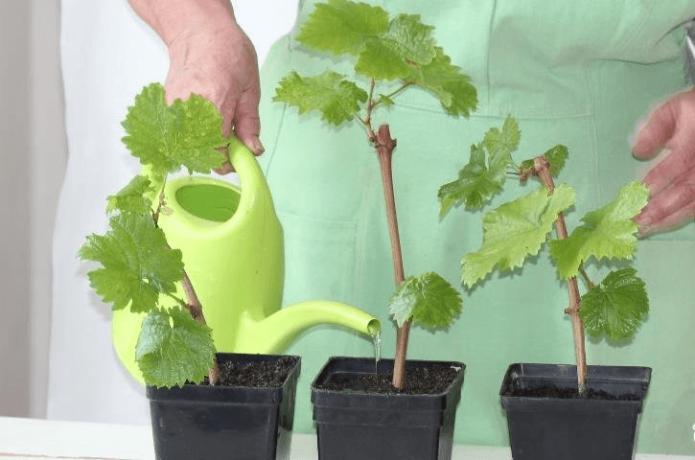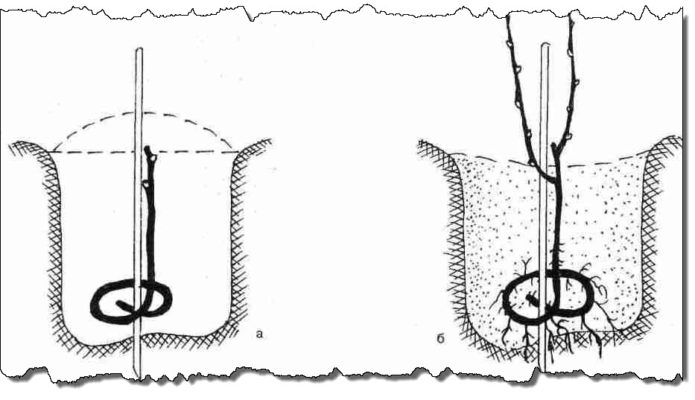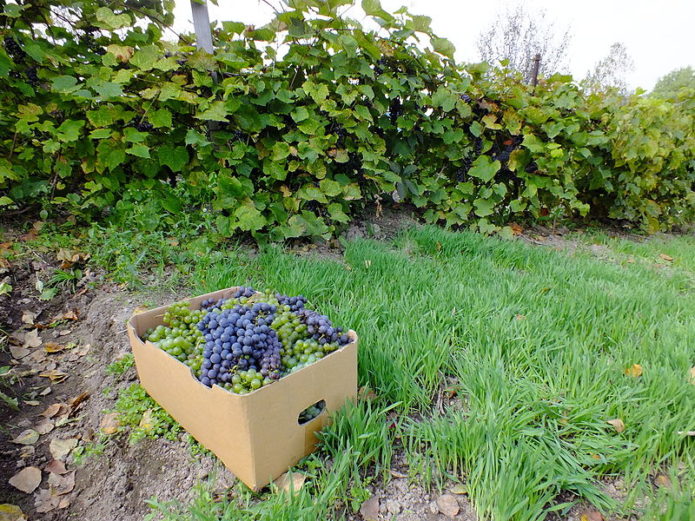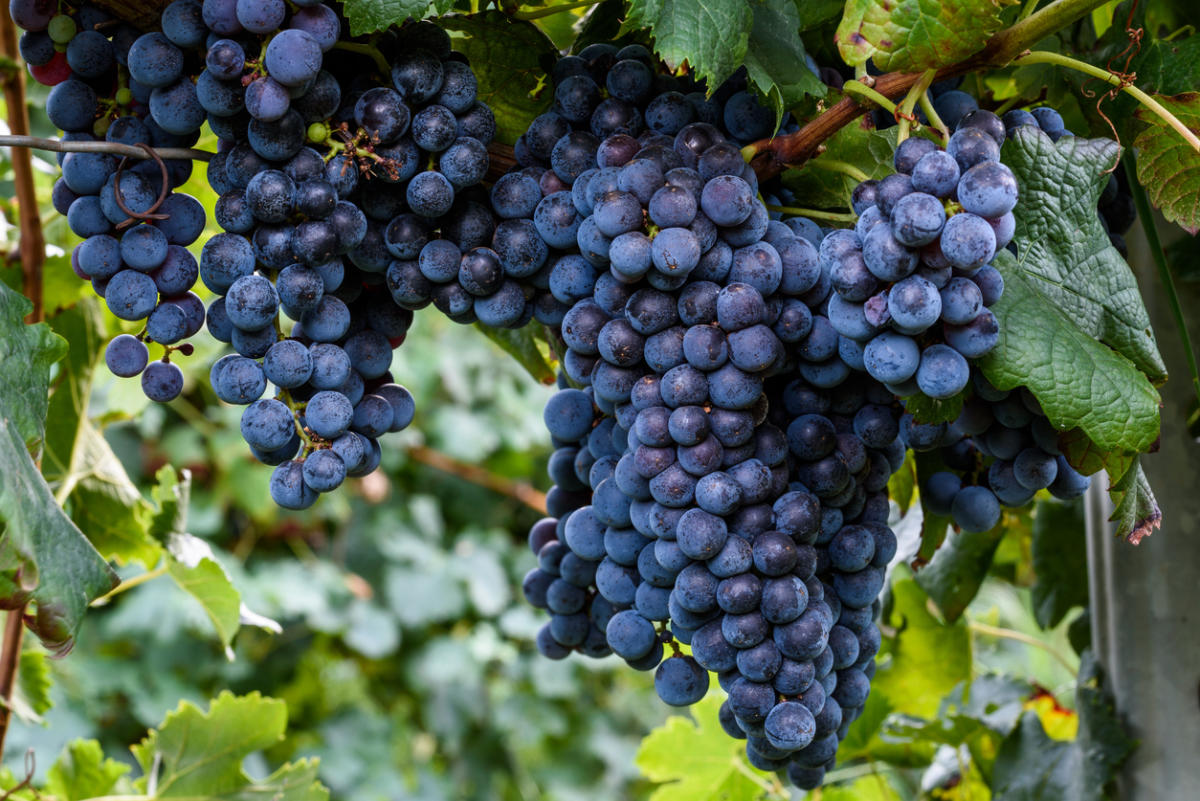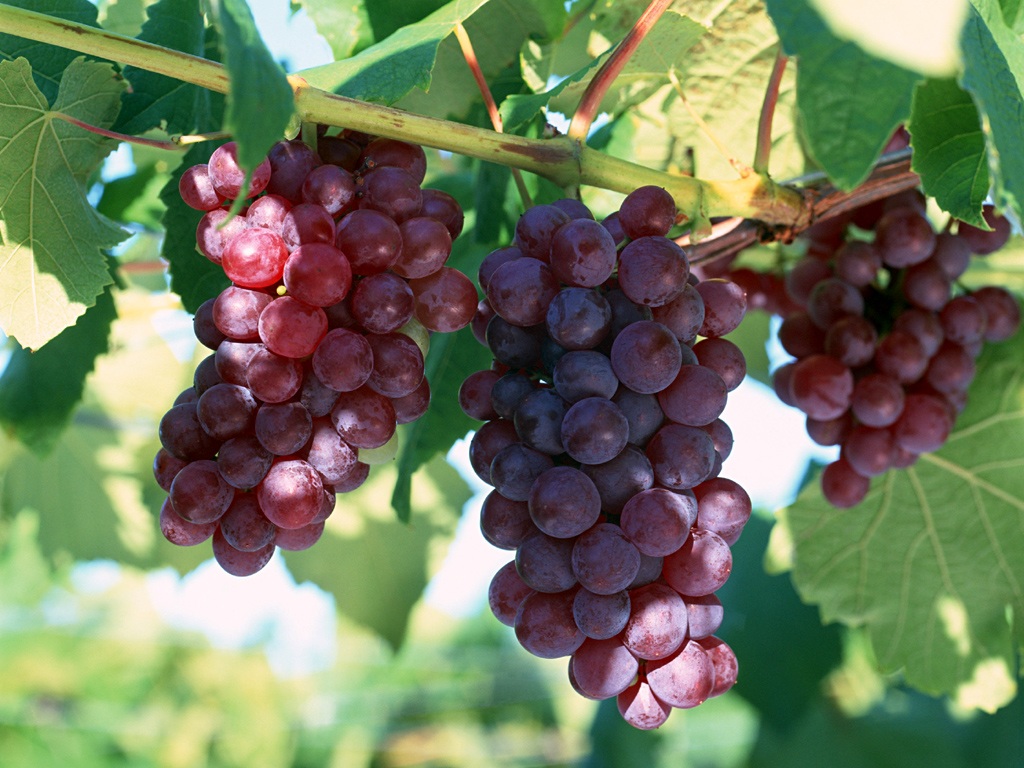Grapes are one of the most common crops on the planet. In southern countries, the plant has been cultivated since antiquity, but it is able to grow and bear fruit also in northern latitudes. The grapes are grown quite successfully in Scotland, Sweden, Norway, central Russia. Even in the Leningrad Region, enthusiastic gardeners “tame” the vine.
Content
Planting grapes
Grapes are able to grow on almost any soil, except that saline and waterlogged ones are categorically not suitable for it. But rocky lands and sandstones are ideal for him. In such soils, water does not stagnate, and the grapes especially do not like the high humidity of both the earth and the air. Therefore, it is easier to grow grapes in Siberia than near St. Petersburg.
The grapes are quite frost-resistant, it can endure -15-18 degrees. Some varieties can even withstand cold temperatures down to -25 degrees. But the winter hardiness of the culture (the ability to withstand winter thaws, spring and autumn frosts) is not high.
Seat selection
The main rule is the more sun the better. The place should be inaccessible to the north wind. Therefore, a sunny area is ideal for planting grapes, illuminated all day long and closed from the north by curtain plants (no closer than 2 m to the vine) or a fence.
You can plant grapes near buildings that will protect it from the wind. It would be logical to place seedlings at some southern wall, but this rule does not apply to all areas. For example, in the northwestern part of Russia, the cold land is poor in humus and warms up slowly. But on the southern side of buildings, the surface of the earth sometimes heats up to temperatures above 20aboutC. In such conditions, the plant wakes up, begins active sap flow. And at night there may be frosts. In this case, the water in the shoots will freeze and tear them apart, the vine will die. Therefore, it is better to plant grapes on the southwest or west side, covering it with planting curtain plants.
A screen made of dark colored planks is suitable for fencing grapes: it will protect from the wind and, when heated in the sun, will give its warmth to the seedlings.
It is necessary to place plantings, stepping back from the building about 75 cm, where the soil freezes less.
Make sure that no water drips from the roof onto the grapes.
The western side does not heat up so quickly, but it does not cool down too soon, giving off its warmth at night. The south-east and south-west are good for a covering form of cultivation. In the greenhouse, you need to arrange plantings from north to south.
The roots of the grapes are located quite deep, so it cannot be planted in areas where the groundwater level is above 1.5 m.
Pit preparation
The size of the landing pit is 60x60 cm, the depth is 0.8–1 m.
Pit preparation:
- Drainage is poured onto the bottom with a layer of 10–15 cm: gravel, brick scrap, pebbles.
- Then the pit is filled with a mixture of gravel, sand and fertile soil in the ratio: 0.5 buckets of sand x 1 bucket of gravel x 3 buckets of fertile soil.
- Be sure to add a deoxidizer - dolomite flour or ash:
- with slightly acidic soil - 1 tbsp. dolomite flour or 1.5 tbsp. ash on a bucket of rubble;
- with sour - 2 tbsp. dolomite or 3 tbsp. ash.
They also reduce the acidity of the soil by introducing chalk, gypsum or crushed eggshell into it.
- At the very top, clean fertile soil is poured with a layer of 25 cm.
- You need to fill the pit gradually, spilling the mixture several times with water and slightly compacting.
- Near the prepared pit, two metal pipes are driven in, one next to the pit, and the other, retreating 1.5 m from the first. A wire (preferably in a plastic sheath) is tied to these pipes at a height of 40-50 cm to make two parallel rows. This will be a trellis.
Soil deoxidation increases the availability of calcium, phosphorus, magnesium and molybdenum to plants, and protects them from harmful supersaturation with aluminum, iron and manganese.
Landing scheme
It is very important to follow the plan for planting new plants. Grapes do not tolerate transplanting, so they plant it once for a long time.
The distance between the seedlings depends on what form of vine cultivation is chosen. A vine is a "sleeve", it can be short (1.5 m) and long (from 2.5 m), it can be the only one on the plant ("one sleeve") or not. Space between plants:
- bush "with long sleeves" - 3 m;
- bush "with short sleeves" - 2 m;
- bush "with one sleeve" - 1.5 m.
Leave a distance of 2–2.5 m between the rows. Strawberries, greens and even vegetables can be grown in these aisles.
Parsley protects the vine from many diseases. Therefore, growing it at the roots of grapes is a great idea.
Planting depth
The depth of the seedling roots depends on the type of soil:
- 40–45 cm on black soil or clay;
- 55-60 cm on sandy ground;
- 50–55 cm on loam and sandy loam.
A deep planting is needed to protect the root system from frost. Grape roots can withstand temperatures as low as -6aboutFROM.
With a high level of groundwater
If groundwater is high at the surface of the earth, then you can:
- Use high embankments and ridges for planting. The ridge should be 0.8–1.5 m wide, 0.4 m high (at least 1 m if the soil is peaty). For spring planting, the structure is prepared in the fall so that the earth settles over the winter. For wintering, the ridges are insulated.
- Lay a piece of slate at the bottom of the planting pit (30–40 cm), and plant a cutting on top in the usual way. The roots will rest against the slate and begin to grow to the sides, and not deeper into the waters.
- For drainage, two grooves are dug (1–1.5 m deep) on both sides of the plant at a distance of 1 m from them. The ditches are filled with broken brick, gravel, and pebbles. The drain should exit into a lowland located below the depth of the drainage ditches.
It is known that grapes can withstand flooding for up to 2 months. There is even such a method of fighting phylloxera disease, when the vineyard is flooded for 60 days.
Planting cuttings without roots
Grapes do not tolerate transplanting, so planting with cuttings (shanks) is the best way to propagate.
Preparation and storage of cuttings:
- Cuttings should be cut in late autumn before being sheltered for the winter. The length of the handle is about 50 cm.
- They are stored on the bottom shelf of the refrigerator or in the cellar with a temperature of 2-4aboutC, tied in bundles and wrapped in paper or cellophane.
- During storage, you need to inspect the cuttings several times: if they are wet, wipe them with a clean napkin, wrap them up and put them back.
- In the spring, you need to make sure that the roots wake up faster than the rest. For this, the earth must be warm and the air cold. 2 weeks before planting, the shafts are planted in the ground at an angle into a container with earth according to a 10x10 cm scheme. A folded towel is laid on the battery, a container is placed on it, the window is kept open all the time. If the leaves are allowed to appear before the roots, they will begin to evaporate moisture from the cutting and the plant will dry out. There is a more convenient way: spill the landing site with hot water (60aboutC), cover with a black film, make cross-shaped cuts in it, where to stick the shanks.
Before planting at the shank, you need to scratch the bark on the lower tip with a needle a little, wet it, dip it in Kornevin, and plant it vertically to such a depth that there are 2-3 buds above the ground. You need to plant the cutting next to the pipe that was driven in during the preparation of the pit. Later, when a vine begins to grow from the shank, it will need to be tied to this pipe with a "figure eight". The ground is covered with black spunbond, fixing it with several stones.
The stones on the garden bed heat up during the day, and at night they warm up everything that is nearby.
Video: how to prepare and store grape cuttings
Fertilizers applied at planting
It is not recommended to apply nitrogen fertilizers during planting, as they interfere with root development. It is enough to add 1-2 tbsp to the top layer of the earth. l. complete mineral fertilizer AVA or any other, mixing it with the soil. You can bring 1 tbsp into the planting pit. ash. Fertilizers will last for up to 3 years.
Watering after planting
Watering is very important for planting grapes. The intensity of moisture depends on the growing area. If the climate is continental, with dry summers, then every day the seedling needs to be watered with half a bucket of water. If the climate is humid, then it is enough to pour the same half a bucket under the seedling once a week. But in any case, the water must certainly be warm! With prolonged cold and rainy weather, watering is stopped.
Features of planting grapes in autumn
The main advantage of planting grapes in the fall is that in the spring the plant will already be ready for an active life. Previously, it was believed that this method is suitable for warm regions. But now there is a positive experience of autumn planting of cuttings in the northern regions, even in the Urals.
You can plant grapes in autumn from October until frost. The planting hole is prepared in the same way as for spring planting. Before planting the seedling, the pit should stand for at least 2 weeks for the earth to settle and compact.
To prepare cuttings you need:
- After leaf fall, take a shoot with a thickness of a little finger or more (from 5 to 10 mm). It is important to take a cutting from the middle of the vine, which is already bearing fruit well.
- Cut a 30–40 cm long stalk with 3–4 buds.
When cutting, you need to use a very sharp tool, ideally a special garden knife.
- Find the bottom eyelet and make a slanting cut below it.
- Make the upper cut horizontally, leaving 2-3 cm above the upper kidney.
- Melt the paraffin or wax and dip the top in it for a few seconds (you can at least cover it with plasticine).
- Dip the lower end into a growth stimulant solution (for example, Kornevin - 1 bag per bucket of water) for a day.
The prepared shank-shank can be planted in a ready-made moist pit. It is better to place it obliquely, at an angle of 45abouttilted to the south, 3 buds should lie in the ground, one above the soil.
For the winter, the seedling needs to be covered: with a layer of earth of 10 cm, then the same thickness with a layer of leaves, on top with more earth 30–40 cm. Above this "sandwich", an arch made of polyethylene is installed.
Features of planting grapes in the lowlands
The grapes do not tolerate the northern slopes, stagnant water and lowlands. However, there is a unique method by A.G. Kudryavtseva. The bottom line is planting grapes in trenches lined with heat-conducting material (boards, brick or slate), which accumulates heat during the day and gives it back at night.
From April to June, the grapes lie in this trench, covered with foil frames (practically in a greenhouse), in warm weather the vine is raised on a trellis, and in the winter they are laid back, covered with insulation.
Grape planting methods
There are different ways of planting grapes. They differ in the method of preparing the site for the seedling and the type of planting material.
Classical
Classic way of planting:
- In the fall, dig a planting hole or trench: the size of the hole is 80x80x60 cm (width, length, depth), the length of the trench is taken taking into account that the distance between the plants should be at least 2 m, and the width and depth - the same 80x60 cm, the distance between the rows - 2.5 m.
The pit is prepared in advance, otherwise the earth will then settle, breaking off the roots of the seedling.
- Fill the hole: at the bottom of 10 cm of drainage (crushed stone, broken brick, trimming boards), then a mixture of crushed stone, sand and fertile soil (half a bucket of sand and 3 buckets of soil on a bucket of crushed stone), add 1.5 tbsp of crushed stone to the bucket. ash or 1 tbsp. dolomite flour and 2 tbsp. l. complete mineral fertilizer.
To enrich the roots with oxygen, you can throw a handful of wheat or barley grains into the pit.
- Take a stalk, harvested in the fall, cut the lower end obliquely under the kidney, the upper end horizontally at a distance of 3-4 cm above the upper kidney, scratch the bark at the bottom of the stalk with a needle.
- Dissolve root formation stimulants (Heteroauxin, Epin, Kornevin or just 1 tablespoon honey) in a bucket of water, put the finished cuttings in water for 2 days at room temperature.
- Move the cuttings to jars or cut plastic containers with clean water (the water level of 5 cm must be maintained at all times), after 2-3 weeks the first roots and green shoots will appear.
If there is too much water, the cutting may suffocate!
- A stalk with roots is planted in a container for seedlings filled with soil (5–7 cm) over a 2-3 cm drainage layer (expanded clay).
- Watering should be done often, but little by little.
- The shoot is pinched so that 2 small branches remain, which after 2 weeks need to be pinched again.
- Rooted cuttings are planted in May - June, when the ground warms up to 16aboutC, watered with 2 buckets of warm water per plant, mulch the soil with 1–2 cm of a mixture of dry earth, sand and sawdust.
On the trellis
By their nature, grapes are a liana, which means that they need support. In the wild, he lives like this, winding around trees and shrubs. Therefore, growing on a trellis is a logical and convenient way.
Supports can be very different in shape and number of planes. All of them consist of support pillars and a wire stretched between them. It is best to make posts from steel or asbestos-cement pipes with a diameter of 50-100 mm, but wood can also be used. Oak pillars will last about 20 years. The wire should be 2–5 mm in diameter, it is better if it has a plastic coating.
The simplest trellis consists of a wire tied to pipes, forming two parallel rows at a distance of 40-50 cm from the soil surface.
For the first two years, it will be enough to simply tie the growing vine to the post. In the 3rd year in the spring, after removing the shelter, a vine is laid on a horizontal trellis, twisting both wires in turn. In the 4th year, you can add another trellis at a distance of 40 cm from the first.
On the ridges
The method of growing grapes on the ridges is suitable for northern areas. Its pluses:
- protection against flooding of the vine in the spring;
- rapid heating of the soil;
- great air permeability of the earth;
- less labor for weed control.
To create a ridge:
- Dig a trench 10 m long, about 25-30 cm deep, 100 cm wide. For better illumination, you need to orient the ridge from north to south.
- Prepare the soil with sand, gravel and fertilizers in the usual way.
- Fill the trench with soil so that the ridge rises 30–35 cm above the ground, and the slopes are gentle.
- The entire ridge or only the slopes can be covered with insulation (spunbond, corrugated cardboard) or mulched.
- To deepen the roots of seedlings 40–45 cm from the surface of the ridge.
- On the perimeter of the ridge, you can dig in dark bottles with the necks down, this will be a kind of solar panels for plant roots, as well as strengthening for the walls of the ridge.
- For watering and feeding, vertically bury a piece of pipe with a diameter of 30–35 cm into the ridge.
In the greenhouse
The greenhouse climate is most favorable for grapes. Due to the increased temperature, the grapes grow faster and begin to bear fruit earlier.
Table: temperature regime for grapes in the greenhouse
| Growing season | Temperature during the day aboutFROM | Temperature at night aboutFROM |
| When budding | 10–40 | 8–10 |
| During shoot growth and flowering | 24–26 | 14–16 |
| During the ripening period of berries | 28–30 | 18–20 |
Planting grapes in the greenhouse:
- Prepare the soil in the greenhouse in the same way as for all other planting methods.
- It is better to root the cuttings in advance in small containers in a warm room.
- Plant in a greenhouse at a distance of at least 1.5 m from each other.
- Cover with spunbond immediately after disembarkation.
- Water once a week, combining watering with top dressing.
Grapes have periods when they do not need to be watered at all: this is the time before and during flowering and before harvesting. If you water the plant during these periods, the color will fly around, and the harvest will slow down ripening.
Into containers
The container method increases the growing season of the seedling in the 1st year of planting. This is especially important in colder areas. The essence of the method is that seedlings (with roots) are planted in spring in large bags (diameter 35 cm, height 40 cm) of black dense polyethylene with a cut bottom.
Process features:
- The packages are placed in a pallet (box covered with foil).
- The soil consists of 1 part of humus and 3 parts of deciduous forest land.
- Before planting, the roots of the seedling are cut off to a length of 10-15 cm, its entire lower part is dipped in a clay mash (you can add a little cow dung and Kornevin powder to the clay).
- The seedling is placed in a bag with soil, the roots are straightened, covered with the remaining soil, and watered with warm water.
- Plants are kept warm at home before budding.
- Then, if the weather permits, they begin to take it out into the air. 2 days put in the shade (for hardening), then you can leave in the sun.
- Water as the soil dries up.
- At night, if there is no frost, you can leave it in the greenhouse.
- They are planted in the ground after the threat of frost has passed.
Moldavian planting
The old Moldavian way of planting grapes is very interesting. It requires a vine at least 60 cm long. Further actions:
- In the spring, you need to twist it several times with a ring, grabbing the turns with a rope.
- Then put in a deep hole, making sure that there are 1-2 buds on the surface.
- To prevent the buds from drying out, pour a pile of earth over the peeking end of the vine.
- Water as needed.
- By autumn, a strong plant will develop from the ringlet, which can give the first indicative berries next year.
The trick is that a large vine has a good supply of nutrition for growing roots, which grow a lot along the entire length. They, in turn, intensively nourish the upper kidneys.
A vine can live for over 100 years without losing its ability to produce excellent fruit.
Planting by thickening
For hot, dry climates, there is a thickened method of planting grapes, when 1 m2 up to 7 bushes are planted. In this case, the grapes are grown in a bush form without a garter. Annual growth is carried out in the flooring. Vines are cut short on a low stem (30–40 cm). On the one hand, it is a very economical way of growing, does not require the installation of supports. On the other hand, the thickening of the shoots is favorable for the development of fungal diseases and the yield decreases with this method.
Growing grapes in different regions
Thanks to the warming climate and the unique plasticity of the vine, it is conquering more and more territories on the planet. Each area has its own climatic and soil characteristics. Having studied them, you can successfully grow grapes by choosing suitable varieties and agricultural techniques.
Table: natural specifics of regions and peculiarities of planting grapes
| Region | Natural features | Landing features |
| Middle zone of Russia | The climate is moderately continental, frosty winters, warm, humid summers. | Spring planting with seedlings germinated in a warm room is preferable. |
| South of Russia | The climate is different: from subtropical (Black Sea coast) to sharply continental dry (Caspian region), from alpine (Caucasus Mountains) to moderately continental (Pridonsk steppes). In any case, the region is favorable for grapes, with hot summers and mild winters. | You can grow unpretentious grape varieties without shelter. Plants should be planted at a distance of 3 m from each other and 3 m between rows. |
| North of Russia | The North of Russia is large, the climate of different zones has its own characteristics. But the main obstacles to growing grapes in the north are short summers with a shortage of active temperatures, long cold winters with thaws. One of the advantages of the north is the long duration of the sunshine. This is beneficial for increasing the yield and sugar content of grapes. | It is necessary to select special varieties of very early and early ripening, winter-hardy and frost-resistant. Plants with Amur grapes among their ancestors live best here. Shelter is a must for the winter. |
| Caucasus | Warm humid climate, lots of sunshine. Thanks to this, the Caucasus is considered the birthplace of grapes. | Here, the grapes do not need shelter, and you can choose any place for planting. |
| Black earth | The climate is moderately continental with a tendency towards aridity. The soils are fertile, light, warm well. | To determine the best time to plant grapes in the Central Black Earth Zone, you can focus on the blooming of birch leaves. If the tree dissolves leaves, it means that the soil has warmed up to 10aboutFrom a depth of 50 cm and you can plant grapes. |
| Primorye | Moderate monsoon climate. Winter is cold, dry and clear. Summers are humid and warm. The frost-free period lasts 150-200 days, so the grapes have time to ripen. The main advantage for growing grapes is the duration of the sunshine receipt over 2000 hours. | To determine the time of planting grapes in Primorye, you need to focus on the budding of Amur grapes in the taiga. This usually happens from 5 to 20 May. You can plant grapes here only in spring. |
| Moscow suburbs | The climate is moderately continental. Winters are moderately cold with a stable snow cover. Summers are moderately hot. | It is optimal to plant grapes in spring and in ridges. Saplings must be selected from the first group of frost resistance (-35aboutC and above).Cover for the winter is mandatory. |
| Siberia | Continental climate, average annual positive temperature of 2100-2200 degrees. | For outdoor cultivation, choose super early varieties. It is best to grow in a greenhouse or covered trench. |
| Ural | The peculiarity of the Urals climate is short summers, which can be hot and dry, humid and cool. Winter temperature in the Urals from -16aboutFrom to -24aboutFROM. | Better to plant grapes in a greenhouse and choose the earliest varieties. |
| Rostov region | The zone is characterized by a lack of moisture with increased solar activity. The winter problem is a sharp temperature drop, there are severe frosts. | Starting from the Rostov region, it is possible to plant grapes not only from the south side of buildings, but also from the west and east. But it is still necessary to provide protection from northern winds. |
| Tula region | Moderate continental: moderately cold winters, warm summers. Soils are mostly clay and loamy, unfavorable for grapes. | Landing only in pits filled with the necessary soil. You can plant both in spring and autumn. Shelter is a must. |
| Voronezh region | The climate is moderately continental, the average January temperature is -9aboutFrom, July - 20aboutC. Climatic and soil conditions are suitable for growing grapes. | Early and super-early varieties are more reliable here. It is imperative to provide for the possibility of shelter from severe frosts and return frosts. |
| Kirov region | Continental climate. Moderately cold winters, warm summers. Winter lasts 4.5 months. The snow cover is significant. | A feature of the soils in the Kirov region is their increased acidity due to coniferous litter. Since grapes cannot tolerate acidic soils, special attention should be paid to liming the soil. |
| Leningrad region | The main disadvantage of the climate is the high humidity of the air and soil. | Grapes do not like moisture, heat is not enough for them in the North-West, so it is better to plant them here in greenhouses or under cover. |
| Chelyabinsk region | The climate is continental, cold long winters, warm or hot summers. Chernozem and northern forest soils. The frost-free period is 90 days. Snow cover - up to 1 m. | It is better to make planting holes larger: 1x1x1 m. When filling the hole with soil, it is useful to use the bones of cattle, they are rich in phosphorus, which gives the grapes sweetness. For the winter, it is imperative to cover the grapes not only by insulating it, but also protecting it from moisture, that is, using a film. |
| Novosibirsk region | Continental climate. Harsh long winters with short thaws, short hot summers. The frost-free period is 120 days. | This area is characterized by recurrent frosts in spring and winter thaws. Therefore, it is imperative to use a shelter until mid-June and insulation with protection from dampness for the winter. |
| Krasnodar region | The main feature of the climate is an excess of sun with a lack of moisture. The soils are chernozem and gray forest podzolic, crushed stone, sandy. A favorable area for grapes. | A wide variety of varieties can be grown. Drip irrigation is preferred. The susceptibility to diseases of grapes is higher than in the northern regions. It is imperative to carry out disease prevention. |
| Khabarovsk region | Monsoon climate. Hot and rainy summers, severe, clear winters with little precipitation. | In the southern regions of the Khabarovsk Territory, cultural early grape varieties also ripen. Covering method of growing. |
| Bashkiria | The climate is continental, moderately hot summers, cold winters. The soils are poor, sandy or heavy clayey. | Plant only in spring, in May. Be sure to prepare the landing pits well. |
| Tatarstan | Moderate continental climate. Warm summers, moderately cold winters. The soils are sod-podzolic, gray forest, black soil in the south. | Planting deep so that the roots do not freeze in winter. The pit must be at least 70 cm deep. The varieties should be chosen early and super early. |
| Vitebsk region | Continental climate with high rainfall. | It is better to plant grapes in ridges of 30-60 cm. Early varieties should be chosen. It is imperative to use a shelter. |
| Bulgaria | The climate is moderately continental, in the south it is Mediterranean. The soil is rich. The sum of active temperatures up to 4500 degrees. | Grapes have been cultivated here for centuries. Shelter is not required. Table varieties are grown. |
| North Kazakhstan | Sharply continental climate. Frosty winters, warm, windy summers. The soils are chernozems, brown and gray-brown. | For landing, you need to choose a place protected from the wind from the north and north-east sides. It is better to plant on the southern side of buildings. |
| Tajikistan | The climate is dry and hot. Soils - light gray gray soils, sandy loam and loam. | Grapes are grown here traditionally and everywhere. Shelter is required in certain areas. Sweet table-raisin varieties are grown. |
| Germany | Temperate climate with an average January temperature of 0aboutFrom, July - 20aboutC. The amount of precipitation for the year is 600–1000 mm. Autumn is long and warm. The south of Germany is a favorable place for growing grapes. | Table grapes are grown on an industrial scale. In mountainous areas, grapes are planted with small aisles and grown in standard form. On the plains, trellises and wide aisles are used. |
In recent years, interest in growing grapes in northern latitudes has grown like never before. A rare gardener has not tried to domesticate a southern vine. Grapes turned out to be not such a bird of paradise in our area. With a competent approach, he happily lives next to us. And it gives not only a tasty harvest, but also the joy of new discoveries, and the pleasure of earned success!
